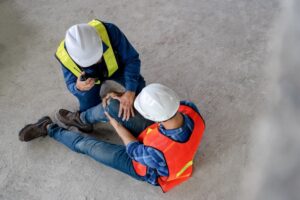Those who suffer injuries in construction accidents deserve compensation. Sometimes, this compensation comes from a workers’ compensation claim, sometimes from a third-party claim, or in some cases, from both. However, a third-party claim after a construction accident can be confusing and challenging.
Construction accidents often involve multiple parties, such as contractors, subcontractors, and equipment manufacturers, which can make determining liability and filing a claim more complicated. Additionally, navigating the legal system and understanding the ins and outs of construction laws and regulations requires skill and experience.
If you have suffered an injury in a construction accident, a skilled construction site accident attorney can help maximize your compensation, including filing a third-party claim.
What Is a Third-Party Claim?
A third-party claim is a type of personal injury claim that allows you to seek compensation from someone other than your employer. Typically, workers’ compensation benefits cover medical expenses and part of your lost wages after a workplace injury. However, workers’ comp doesn’t cover everything—you may not receive compensation for pain and suffering or future medical needs, for example. This is where a third-party claim can help.
If someone other than your employer or a co-worker played a role in causing your construction site accident, you may have the right to hold that third party responsible for their actions. A third-party claim seeks damages directly from the individual or company that contributed to your injury, allowing you to pursue additional compensation that wouldn’t otherwise be available under workers’ comp.
Common Third-Party Examples in Construction Accidents

- Contractors or Subcontractors – Did someone working for another company behave recklessly or negligently, leading to your injury? If they weren’t your employer but still played a role in the incident, they might be held liable.
- Equipment Manufacturers – If defective or malfunctioning tools, machinery, or safety equipment caused your accident, the manufacturer or distributor may be legally responsible.
- Property Owners – If the person or company that owns the construction site failed to maintain safe working conditions or address hazardous conditions, they could be held accountable for causing your injury.
- Vendors or Delivery Companies – If delivery drivers or vendors working independently caused your accident, you may have a claim against them.
By identifying all potentially liable parties, you open the door to pursuing the financial support you need to truly recover from your injury.
Types of Construction Accidents
Construction sites are known for their inherent risks, and accidents can occur in various ways. Understanding the different types of construction accidents is essential when filing a third-party claim. Here are some common types of construction accidents:
- Falls: Falls from heights, such as scaffolding or ladders, are a leading cause of construction site injuries. These accidents can result in severe injuries, including broken bones, spinal cord injuries, and traumatic brain injuries.
- Electrocutions: Construction sites often involve working with live electrical components. Accidental contact with exposed wires or faulty equipment can lead to electrocutions, causing burns, organ damage, or even death.
- Struck-by Accidents: Construction workers are at risk of being struck by falling objects, swinging cranes, or vehicles on the job site. These accidents can cause broken bones, internal injuries, or even fatalities.
- Caught-in/Between Accidents: Construction workers can become stuck, crushed, or trapped between heavy machinery, collapsed structures, or excavation sites. These accidents often result in crippling injuries or death.
- Machinery Accidents: Working with heavy machinery, such as forklifts, cranes, or bulldozers, poses a significant risk. Accidents involving machinery can lead to severe injuries, amputations, or permanent disabilities.
- Construction Vehicle Accidents: Construction sites are bustling with various vehicles, including trucks, loaders, and excavators. Accidents involving these vehicles can cause significant injuries or fatalities.
- Trench collapses: Construction workers who work in trenches or excavations are at risk of being buried or trapped in collapses. These accidents can cause suffocation, crush injuries, and death.
- Exposure to hazardous substances: Construction workers may be exposed to toxic chemicals, asbestos, silica dust, or other harmful substances. Prolonged exposure can result in respiratory diseases, cancer, and other severe health conditions.
When you have been involved in a construction accident, it is critical to determine who may be held liable for your injuries. Identifying the responsible party is an essential step in filing a third-party claim.
How Much is a Third-Party Construction Accident Claim Worth?

Here are some key factors that may influence the value of your third-party construction accident claim:
- Medical Expenses: The cost of medical treatment, including hospitalization, surgeries, rehabilitation therapies, medications, and ongoing medical care, will play a significant role in determining the value of your claim.
- Lost Earnings: If your construction accident injuries prevent you from returning to work, you may be entitled to compensation for your lost earnings and the potential future earnings you may miss out on.
- Pain and Suffering: Compensation for physical pain, emotional distress, and the loss of enjoyment of life can be sought in a construction accident claim. The value of pain and suffering damages can vary depending on your injuries’ severity and long-term impact.
- Disability and Impairment: If your construction accident resulted in a long-term disability or impairment that affects your ability to work or perform daily activities, the value of your claim may increase to account for future medical expenses and loss of earning capacity.
- Property Damage: If any of your personal belongings, such as tools or equipment, were damaged in the construction accident, you can seek compensation for the cost of repair or replacement.
- Loss of Consortium: In cases where a construction accident has caused severe injuries or death, the spouse or family members may be entitled to compensation for the loss of companionship, support, and consortium.
A lawyer can determine the exact worth of your third-party construction accident claim. They can evaluate the unique circumstances of your case and negotiate with the responsible parties or their insurance companies to help ensure you receive fair compensation for your injuries.
The Process of Filing a Third-Party Claim After a Construction Site Accident
If you’ve been injured in a construction site accident, you may feel overwhelmed by what lies ahead—managing your physical recovery, addressing financial concerns, and navigating complex legal processes. Filing a third-party claim can be a crucial step toward securing the compensation you need to rebuild your life. Here’s a breakdown of the process:
Seek Medical Attention Immediately
Your health and safety are the top priorities. Even if your injuries seem minor at first, seeking immediate medical care is essential. Construction accidents can cause hidden injuries that may worsen over time, such as internal damage or concussions.
Medical treatment not only ensures your well-being but also documents your injuries, creating critical evidence for your claim. Save copies of all medical reports, bills, and prescriptions—these will be vital in establishing the impact of the accident.
Report the Accident Promptly
It’s important to officially report the accident to your employer or site supervisor as soon as possible. This step creates a formal record, which can protect you if questions arise later about how or when the accident occurred. Be clear, accurate, and thorough in describing what happened. An incident report will support both your workers’ compensation claim and any third-party claim you pursue.
Identify Who May Be Liable
A third-party claim specifically targets someone other than your employer who may have contributed to your accident. Construction sites can involve multiple parties, such as contractors, subcontractors, equipment manufacturers, property owners, or delivery companies. Ask yourself key questions as you evaluate liability, such as:
- Was faulty equipment involved?
- Did inadequate site maintenance contribute to unsafe conditions?
- Was another contractor’s negligence responsible?
This step may feel challenging, but identifying the person or company responsible is essential for filing your claim. An experienced attorney can help investigate potential liable parties, particularly if the circumstances are complex or unclear.
Collect Evidence to Support Your Claim

Request a copy of the incident report and gather the contact information of any witnesses who saw what happened. Their statements can provide crucial support for your claim. Keep a detailed record of medical bills, doctors’ notes, and any diagnoses related to your injury. Additionally, collect proof of lost wages if your injury has kept you from working. This evidence will paint a clear picture of how the accident has impacted your life and your financial stability.
Calculate the Full Value of Your Claim
A third-party claim goes beyond covering basic medical costs. You can seek compensation for a wide range of damages, including:
- Current and future medical expenses
- Lost wages and diminished earning capacity
- Physical pain and emotional suffering
- Loss of enjoyment of life or mobility
- Long-term rehabilitation or therapy
It’s important to think about the long-term consequences of your injury. A qualified attorney can help assess your case and determine a fair claim amount that accurately reflects your losses, both current and future.
Consult a Personal Injury Attorney
Dealing with a third-party claim can be complicated, particularly if multiple parties are involved or liability is disputed. A skilled construction accident attorney will act as your advocate, guiding you through the legal process step by step. They will help investigate the details of your accident, identify liable third parties, gather necessary evidence, and ensure that your claim is filed properly within any applicable deadlines.
An attorney can also manage communication with the responsible parties or insurance companies, providing you with peace of mind so you can focus on your recovery.
Negotiate or Take Your Claim to Court
Once your claim is filed, the next phase typically involves negotiations with the at-fault party or their insurance provider. Your attorney will work to secure a settlement amount that fairly compensates you for your injuries and losses. Many claims are resolved during this stage, but if the other party refuses to offer fair compensation, your attorney may recommend taking the case to court.
Litigation can be an intimidating prospect, but a dedicated legal team can prepare your case thoroughly and fight to ensure your voice is heard. Whether through settlement or trial, the goal is to secure the compensation you deserve to move forward.
The Statute of Limitations for Construction Accidents
The statute of limitations refers to the time limit within which a construction accident victim can file a claim. In construction accident cases, the statute of limitations varies from state to state. In Missouri, the timeframe for filing a personal injury claim is five years. However, it is best to consult with a knowledgeable personal injury lawyer to understand the specific deadline in your jurisdiction, as some factors could shorten or lengthen the timeframe.
Failing to file a claim within the specified deadline can result in the loss of your right to seek compensation. Therefore, act promptly and consult with a well-versed attorney as soon as possible after a construction accident.
While each state has its statute of limitations, seeking legal counsel and initiating the claims process as early as possible is generally advisable. Early intervention allows your attorney to collect valuable evidence, conduct a thorough investigation, and build a solid case to maximize your chances of receiving fair compensation for your injuries.
Contact a Seasoned Construction Accident Attorney Today for Help
Filing a third-party claim can result in additional compensation beyond what is available through workers’ compensation. However, identifying the liable parties and proving their negligence can be complex, making it your best choice to have the guidance of a construction accident attorney.
Don’t let a construction accident derail your life. If you have suffered an injury in a construction accident, you need a seasoned construction accident attorney who will fight tirelessly for your rights. Contact one today to schedule a free consultation. Let them handle your legal case while you focus on your recovery.
By calling today, you’re taking the first step towards protecting your rights and seeking justice. An experienced personal injury attorney from Cook, Barkett, Ponder & Wolz can provide you with the support you need to navigate the legal system. They’ll review the facts of your case and help you understand your options moving forward. Contact us today at (573) 335-6651 or through our online form for a free consultation to discuss your case and legal options.


